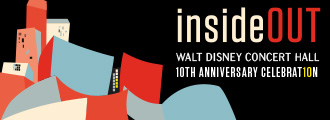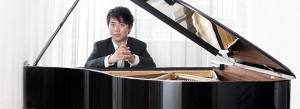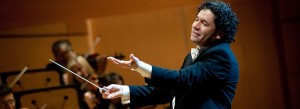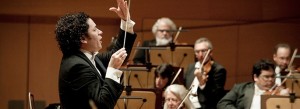A PROGRAM WHICH IS AN ARGUMENT FOR LIVE CONCERTS
LA Phil’s concert last night offered more than enough reasons to validate why live music is far preferable to recordings. The evening’s centerpiece, pianist Lang Lang’s buttery and strong interpretation of Prokofiev’s Piano Concerto No. 3, was a sight to see. Prokofiev trademarks’”bursts of mischievous jocularity, an almost uncontainable pulsating drive, and a blend of audaciousness and lyricism’”are fascinating to watch, especially when with intertwined digits the pianist is flawlessly executing the intricate fingerwork and cross-hand jumps of this 1921 concerto. Lang Lang, who watches the orchestra for long stretches without looking at the ivories, goes beyond mere confidence into a realm of relaxation and apparent effortlessness’”he’s a sublime nonchalant monster machine with a heart. As unscholarly as it sounds, his hands seem like they are moving four billion miles a second. While I wish that conductor Gustavo Dudamel quieted his players a bit so we could hear every note on that keyboard, it was still so thrilling that the opening night audience held after the first movement only to suddenly break into thunderous applause just as the second movement was about to begin; that’s an energy that is quite something to experience live.
Aside from the special feeling that this concert is only for you and shall never be duplicated, it’s a shared communal experience which is heightened by an LA Phil premiere that most have never heard before. And when it’s a work as fascinating, pleasurable, and original as Paul Desenne’s 18-minute SinfonÃa Burocratica ed’Amazzonica (2004), a “tropical chamber symphony in five tableaux,” senses are intensified, spirits are elevated, and the imagination is allowed to run riot.
With the composer in attendance, Dudamel brings his uncanny knack of releasing character from his principal players in the SinfonÃa. Along with an amazing display of percussion in “La Leçon,” violinist Martin Chalifour, flutist Catherine Ransom, and trumpeter Thomas Hooten cover the clickety-clack of bureaucracy and the wild creatures of South America. After the slinky orchestrations of the second movement, “Anaconda,” harpist Lou Anne Nell suggests a peaceful scene of steamy gloom in “Guasarana,” written in 5/8 meter. Clarinetists Burt Hara and David Howard have a field-day with the rhythms of “Bananera,” built around the cumbia, Latin-American dance music of Colombian origin, similar to salsa; with Nitzan Haroz on muted trombone, the dance structure which Desenne calls “laid-back” sounds awfully groovy to me. The finale, “Death of the Automobile,” plays on the ultimate confrontation between rural South American poverty and the dying machine, so the use of scratched cylindrical percussion and Norman Pearson’s tuba called to mind a car sputtering down a hill.
Also setting the brain awash with images is Maurice Ravel’s Valses nobles et sentimentales (1911), a suite of eight waltzes both impressionistic and modern written as an homage to Franz Schubert. It’s true that the waltz is synonymous with dance, but for me, waltzes evoke other types of movement as well. Conducting the 1912 orchestral version from memory, Dudamel intensifies the work’s colors such that concentrating on the music live allows me to conjure up glorious images: The intense expression of Julian Beaudiment’s flute during the “Assez lent,” with its Debussy-like symbolism, has me walking through a field of flowers painted by Monet, and oboist Ariana Ghez turns the almost surreptitious “Modéré,” into a countryside fling. Other suites suggest cavorting and conversing after dinner in a café and gliding in a boat throughout some mysterious grotto.
The closing piece to this program which runs through Sunday is the ever-popular La valse by Ravel. There were no images for me here; this is simply a treat just to watch the players and hear their astounding synchronicity. Dudamel’s leadership builds the work appropriately, giving the 1913 work of swirling waltzes not just power, vigor, and rapture, but an incredibly stimulating volume that snugly fits Disney Hall. With an awesome blend of technique and character among the musicians, this work is also an argument for the reason LA Phil is held as one of the finest orchestras in the world.
photos courtesy of LA Phil
Los Angeles Philharmonic
Gustavo Dudamel, conductor
Lang Lang, piano
RAVEL: Valses nobles et sentimentales
PROKOFIEV: Piano Concerto No. 3 in C major, Op. 26
DESENNE: SinfonÃa Burocratica ed’Amazzonica
RAVEL: La valse
Walt Disney Concert Hall
135 North Grand Avenue
Friday May 9, 2014, at 8 PM
Saturday, May 10, 2014, at 8 PM
Sunday, May 11, 2014, at 2 PM
for tickets, call 323.850.2000 or visit www.LAPhil.com





